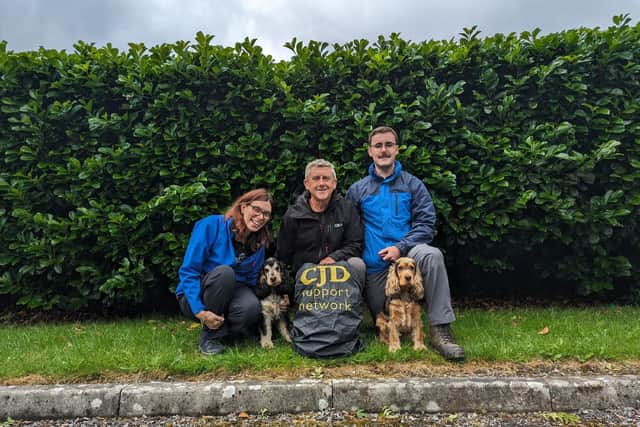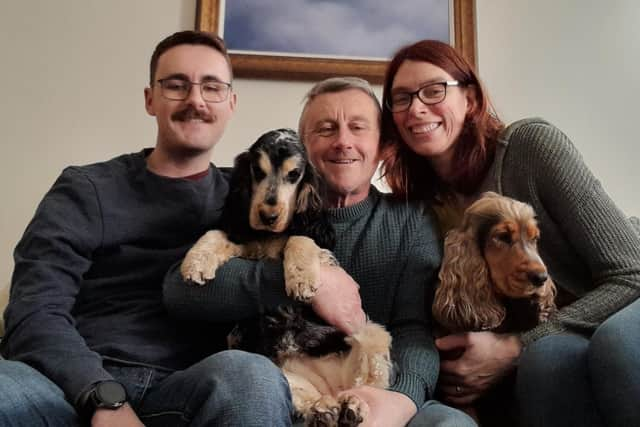'Have I dodged the bullet?' - Yorkshire man tells of life on the edge waiting to see if fatal CJD develops after childhood injections
“I wanted to protect my mum, even more than myself, and so I got in the car and spent hours taking down every notice I could”, the now 58-year-old says.
For a decade of his life Dave, from Otley, had received human growth hormone injections. He was initially given them, from the age of 11 in 1976, at his local GP surgery.
Advertisement
Hide AdAdvertisement
Hide AdBut his mum, an auxiliary nurse, soon took over, administering them three times a week at the family home.


Those years, he reflects, seemed to be the “worst of my life”. The skin on his buttocks became hardened from the needles and there were occasions when teenage Dave ran away from home to try to evade the injection routine and feel, as he puts it, like “a normal child”.
At last, aged 21, doctors gave him the news he wanted. "I was told I didn’t need them (anymore) and I was so relieved that I was finished with them.”
Fast-forward a decade and in his 30s, Dave received a letter asking him to make urgent contact with the professor who had monitored his progress whilst he was receiving the injections. It was a meeting that would turn his life upside down.
Advertisement
Hide AdAdvertisement
Hide AdDave says he was told he was potentially at risk of developing Creutzfeldt-Jakob disease (CJD). The condition is rare and fatal and affects the brain, causing brain damage that worsens rapidly over time.


“It was awful. I didn’t know what to do. I tried to end my life because I didn’t want this to win," he says, the emotion clear in his voice.
"Then I thought no I’m going to beat it. There was all these different emotions. I was just absolutely done for – and my mum was.”
Dave had been one of thousands of children treated with the human growth hormone between 1958 and 1985, which at the time was extracted from a gland at the base of the skull of human corpses.
Advertisement
Hide AdAdvertisement
Hide AdIt emerged that some of those hormones received had been taken from glands infected with CJD. Since then, all human growth hormone in the UK has been artificially manufactured, eliminating the risk.
But Dave has lived his life on edge, uncertain whether he was impacted and whether iatrogenic CJD will suddenly develop and cost him his life.
“I have had something injected into my body and then been told potentially you could die Dave…You’ve got to live from day to day. I’m a strong person but it engulfs your life.”
Members of the media got whiff that Dave was potentially affected. He recalls reporters “hounding us” at home. Neither he or his mum gave an interview, but the headline still emerged.
Advertisement
Hide AdAdvertisement
Hide AdIt was the 1990s and around that time, a link had been discovered between a different type of CJD and bovine spongiform encephalopathy (BSE, or "mad cow" disease). That particular CJD variant is likely to be caused by consuming meat from a cow infected with the disease.
“People would cross over the road to get away from me,” Dave says. “They wouldn’t have anything to do with me. People were thinking CJD [would spread] like the cold or flu but you cannot contract it like that.
"I went to ground. I had to keep saying to myself, just try and live your life quietly.”
The ordeal affected both Dave and his mum and the pair slipped into depression and struggled to cope.
Advertisement
Hide AdAdvertisement
Hide Ad“My life spiralled downhill and I went to some very dark places, mentally,” Dave recalls. “Those were really bad times and I thought the whole world was against me.”
For a number of years now, Dave has been attending the National Prion Clinic in London.
Funded by the NHS to provide diagnosis and care for patients with, or suspected to have, CJD, the clinic plays a key role in facilitating research to promote early diagnosis and the development of potential therapies.
The clinic carries out testing in Dave to look for any signs of the disease developing, as well as taking samples to support research into CJD and future treatments.
Advertisement
Hide AdAdvertisement
Hide AdDave is acutely aware that most people with the disease will die within a year of symptoms starting.
“There isn’t a cure – it’s a killer,” he says. “In many cases, it is misdiagnosed as Alzheimer’s or dementia.
"After each visit I have been told that I am fit and well, with no sign of CJD. The doctors say that I seem to have ‘dodged the bullet’, but can never be 100 per cent sure.
“I am now left wondering, have I survived? Have I exceeded the maximum gestation period of the disease, or not? Even if it is 99.999 per cent, there is always that ‘what if?’”
Advertisement
Hide AdAdvertisement
Hide AdNow, Dave is sharing his story as he prepares to walk the Dales Way from August 18 to raise awareness of CJD and its symptoms and to support The CJD Support Network.
He’s set to take on the 80-mile challenge with his son Jack and two cocker spaniels Mable and Beryl, backed by his partner Jo.
"Miraculously, I'm still here," Dave says. “I found myself in this situation and I thought I would have been dead by now. I'm wanting to do all I can to raise awareness…
"Though this disease has taken over my life and I am still not out of the woods, I am turning it around into something positive and helping others. I understand, I know what this feels like, and I want to do my best.”
To support Dave, visit www.justgiving.com/page/dave-richardson-1685563936521 For more on CJD, visit www.nhs.uk/conditions/creutzfeldt-jakob-disease-cjd or cjdsupport.co.uk
